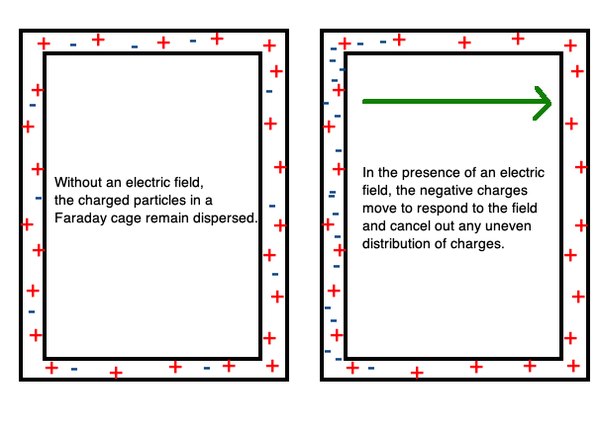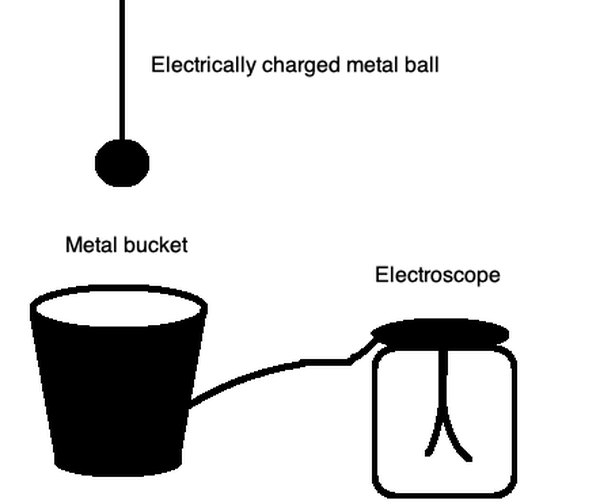
Electricity can be dangerous, but taking the appropriate safety precautions can let you study how charges flow, how electric fields occur and how other phenomena in electricity function.
Since the dawn of electricity in physics, scientists have used equipment to shield themselves from harm when performing experiments. This knowledge would create Faraday cages as methods of preventing people from getting hurt by electricity.
Faraday Cage

Faraday cages or Faraday shields block electromagnetic fields using conductive materials on their surface to redirect electromagnetic waves. The external electric field causes the electric charges in the cage's material to change in how they're distributed with respect to the electrostatic induction to prevent the field from entering the inside of the cage.
Though they can't block slow varying magnetic fields like that of the Earth, Faraday cages have been used to create rooms surrounded by metal meshes or perforated sheets to prevent electromagnetic currents from entering.
Tips
Faraday cages prevent electromagnetic fields from entering or escaping and can be built from aluminum or metallic substances. They can be made with simple materials including metallic wire and cardboard or wood.
When an external electric field comes into contact with the cage, the cage generates the same electric field as though the charge were placed inside. The surface is neutralized with excess charge flowing to the ground if the cage is grounded. This prevents voltage from forming on the other side of the cage so the field doesn't pass the material. The charges redistributed themselves on the other side of the material as electrostatic charges are induced on the surface.
Faraday Cage DIY
This method of building a Faraday cage requires metallic sheets of copper or aluminum, tape, scissors, a cardboard or similar material container and a balloon to test whether the cage works. The material that works best is aluminum, copper or chicken wire for a chicken wire Faraday cage. Faraday cages require a lot of contact between the metal components so a mesh design can work well.
Form the container into a Faraday shield or cage by turning it into, for example, a box that can protect you from your surroundings. Wrap the foil or metallic sheets around the container. Make sure the cage has a lot of contact between the sheets of metal.
Cut a screen so that you can see the outside from inside the cage. Make sure the holes are smaller than the wavelength of the electromagnetic radiation you want to block from entering.
Some general instructions are:
- Measure out a 10 x 10 inch square of screen metal mesh and cut it out.
- Similarly, cut five 8-inch lengths of wood or cardboard.
- Staple, tape, or fasten in some other method the metal mesh to the wood or cardboard.
- Join the strips around the mesh about 5 to 6 inches away from each other so that they cover or surround the entire mesh.
- Form the material into a box or container to create the Faraday cage.
Faraday Cage Wifi
Try using your cell phone inside the cage. Does it receive or transmit the wifi signals? You should still get a weaker amount of wifi because Faraday cages can attenuate the frequency of cell phones, but not completely stop it.
Radio waves that cell phones use have small enough frequencies to leak through small holes in the cage so you would need to solder or weld small gaps in the Faraday cage to act against them.
Faraday Cage Applications
Chemists use Faraday cages to reduce noise from external sources while making precise measurements. Digital forensics researchers use Faraday bags, Faraday cages made of flexible metallic fabric, to prevent remote wiping and alteration of criminal evidence.
Faraday cages provide security for computers to thwart actions such as spying. Cars and planes act essentially as Faraday cages by keeping passengers from coming into contact with harmful electric charges.
Faraday cages are also used in preventing radio transmitters from interfering with other equipment and protecting individuals and objects from currents of lightning strikes and discharges. Household appliances use them, too. Microwaves have shields to prevent waves from exiting their interior while TV cables reduce external electromagnetic interference to create images.
Different conductivity of metals can affect how Faraday cages prevent electric fields from entering. Copper is the most effective, used in hospital MRI facilities and computer appliances, that can be formed into brass and phosphorous bronze alloys for even more specific purposes.
Aluminum is a good material as well because it is strong for its weight and has a high conductivity, but it can rust over time and isn't soldered well. Other features in designing Faraday cages include price, corrosion, thickness, malleability, frequencies that are blocked and how the materials themselves can be formed into a cage.
Faraday Cage Physics

Faraday cages protect their insides from electric fields, a force field surrounding charged particles such as protons or electrons. Coulomb's law can be used to describe the electric force E as
in which r is the radius between to charged particles, ε0 is a constant number of vacuum permittivity of 8.854 × 10−12 F⋅m−1 and e1 e2 are the charges of the particles.
When inside the cage, any electricity that comes into contact with the outer surface can be measured using this formula. The net field inside the cage remains zero, protecting whatever is inside of the cage.
The charges in a conductor, such as the conducting material of a Faraday cage, at equilibrium should be as far apart as possible so the charge remains on the surface. This keeps the electric field inside zero. If you brought a positively charged object to the outside of the cage, the electrons on the inner surface would accumulate around it to cancel it out.
Faraday Cage House
If you imagined yourself in a Faraday cage house, you could use different materials to shield yourself from electromagnetic interference.
Copper is the most reliable element for magnetic resonance imaging (MRI) applications in medicine to shield people from the harms of electromagnetic radiation. It is also easy to combine with other elements to create alloys like brass, phosphorous bronze and beryllium copper that have higher values of conductivity.
Pre-tin plated steel is a cost-effective material that blocks lower frequencies from entering. Carbon steel is another ideal choice that can block frequencies other alloys and elements miss. These materials often come with tin plating to prevent them from corroding.
Copper alloy is known for being able to resist corrosion. Aluminum is another ideal choice that, while you need to examine its galvanic corrosion and oxidation properties, can serve a variety of applications due to its good strength-to-weight ratio and high amount of conductivity.
Faraday Cage for Generator History

In 1836, physicist Michael Faraday observed a charged conductor would store excess charge inside the material itself, not in the cavity that the conductor enclosed. He coated a room with metal foil. With an electrostatic generator outside, he noticed there was no charge inside according to his electroscope, a device used to measure electric charge. He used that to build a Faraday cage for this generator.
Seven years later Faraday demonstrated the charge remains on the surface of a conductor for metallic surfaces. Using a metal bucket with ice, he showed the electric charge in a shell of a conductor creates a charge on the inner surface of the shell. The charge didn't affect the interior volume of the shell. Using an electroscope to measure electric charges, his experiment would become the first quantitative experiment on electric charge.
References
- Physics Classroom: Coulomb's Law
- Backyard Brains: DIY Faraday Cage
- National High Magnetic Field Laboratory: Faraday's Ice Pail
- Leader Tech: The Three Most Popular Shielding Metals and What You Should Know About Them
- Physics Stack Exchange: What is the relationship between Faraday cage mesh size and attenuation of cell phone reception signals?
Tips
- The point of a Faraday cage is that it is a complete shell. Make sure you fold the aluminum foil around the cell phone so there is contact everywhere. Make sure you have good contact when taping sheets of foil together.
About the Author
S. Hussain Ather is a Master's student in Science Communications the University of California, Santa Cruz. After studying physics and philosophy as an undergraduate at Indiana University-Bloomington, he worked as a scientist at the National Institutes of Health for two years. He primarily performs research in and write about neuroscience and philosophy, however, his interests span ethics, policy, and other areas relevant to science.
